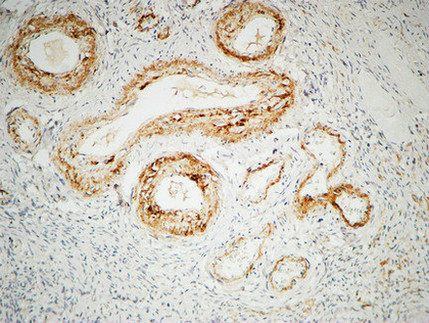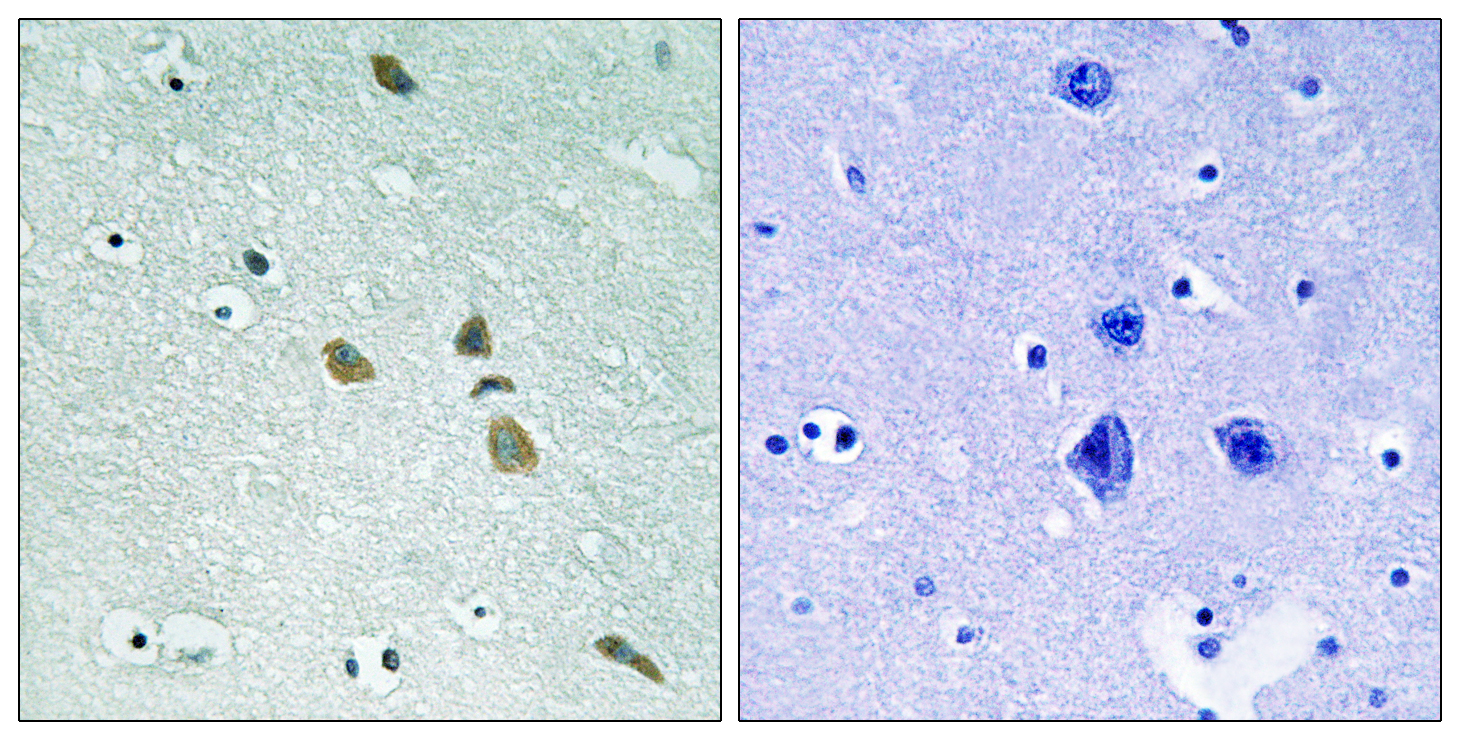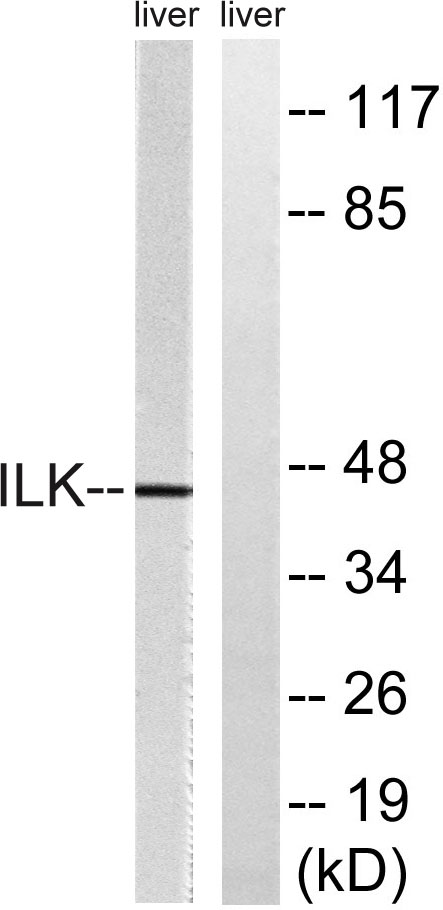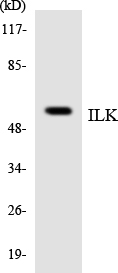ILK Polyclonal Antibody
- Catalog No.:YT2346
- Applications:WB;IHC;IF;ELISA
- Reactivity:Human;Mouse;Rat
- Target:
- ILK
- Fields:
- >>PPAR signaling pathway;>>Axon guidance;>>Focal adhesion;>>Bacterial invasion of epithelial cells;>>Shigellosis;>>Endometrial cancer
- Gene Name:
- ILK
- Protein Name:
- Integrin-linked protein kinase
- Human Gene Id:
- 3611
- Human Swiss Prot No:
- Q13418
- Mouse Gene Id:
- 16202
- Mouse Swiss Prot No:
- O55222
- Rat Gene Id:
- 170922
- Rat Swiss Prot No:
- Q99J82
- Immunogen:
- The antiserum was produced against synthesized peptide derived from human ILK. AA range:212-261
- Specificity:
- ILK Polyclonal Antibody detects endogenous levels of ILK protein.
- Formulation:
- Liquid in PBS containing 50% glycerol, 0.5% BSA and 0.02% sodium azide.
- Source:
- Polyclonal, Rabbit,IgG
- Dilution:
- WB 1:500 - 1:2000. IHC 1:100 - 1:300. ELISA: 1:5000.. IF 1:50-200
- Purification:
- The antibody was affinity-purified from rabbit antiserum by affinity-chromatography using epitope-specific immunogen.
- Concentration:
- 1 mg/ml
- Storage Stability:
- -15°C to -25°C/1 year(Do not lower than -25°C)
- Other Name:
- ILK;ILK1;ILK2;Integrin-linked protein kinase;59 kDa serine/threonine-protein kinase;ILK-1;ILK-2;p59ILK
- Observed Band(KD):
- 42kD
- Background:
- This gene encodes a protein with a kinase-like domain and four ankyrin-like repeats. The encoded protein associates at the cell membrane with the cytoplasmic domain of beta integrins, where it regulates integrin-mediated signal transduction. Activity of this protein is important in the epithelial to mesenchymal transition, and over-expression of this gene is implicated in tumor growth and metastasis. Alternative splicing results in multiple transcript variants. [provided by RefSeq, Jun 2013],
- Function:
- catalytic activity:ATP + a protein = ADP + a phosphoprotein.,domain:A PH-like domain is involved in phosphatidylinositol phosphate binding.,enzyme regulation:Stimulated rapidly but transiently by both cell fibronectin interactions, as well as by insulin, in a PI3-K-dependent manner, likely via the binding of PtdIns(3,4,5)P3 with a PH-like domain of ILK.,function:Receptor-proximal protein kinase regulating integrin-mediated signal transduction. May act as a mediator of inside-out integrin signaling. Focal adhesion protein part of the complex ILK-PINCH. This complex is considered to be one of the convergence points of integrin- and growth factor-signaling pathway. Could be implicated in mediating cell architecture, adhesion to integrin substrates and anchorage-dependent growth in epithelial cells. Phosphorylates beta-1 and beta-3 integrin subunit on serine and threonine residues, but also
- Subcellular Location:
- Cell junction, focal adhesion . Cell membrane; Peripheral membrane protein; Cytoplasmic side . Cell projection, lamellipodium . Cytoplasm, myofibril, sarcomere .
- Expression:
- Highly expressed in heart followed by skeletal muscle, pancreas and kidney. Weakly expressed in placenta, lung and liver.
- June 19-2018
- WESTERN IMMUNOBLOTTING PROTOCOL
- June 19-2018
- IMMUNOHISTOCHEMISTRY-PARAFFIN PROTOCOL
- June 19-2018
- IMMUNOFLUORESCENCE PROTOCOL
- September 08-2020
- FLOW-CYTOMEYRT-PROTOCOL
- May 20-2022
- Cell-Based ELISA│解您多样本WB检测之困扰
- July 13-2018
- CELL-BASED-ELISA-PROTOCOL-FOR-ACETYL-PROTEIN
- July 13-2018
- CELL-BASED-ELISA-PROTOCOL-FOR-PHOSPHO-PROTEIN
- July 13-2018
- Antibody-FAQs
- Products Images

- Immunohistochemical analysis of paraffin-embedded Human ovary. 1, Antibody was diluted at 1:200(4° overnight). 2, High-pressure and temperature EDTA, pH8.0 was used for antigen retrieval. 3,Secondary antibody was diluted at 1:200(room temperature, 30min).

- Immunohistochemical analysis of paraffin-embedded Human kidney. 1, Antibody was diluted at 1:100(4° overnight). 2, High-pressure and temperature EDTA, pH8.0 was used for antigen retrieval. 3,Secondary antibody was diluted at 1:200(room temperature, 30min).

- Immunohistochemistry analysis of paraffin-embedded human brain tissue, using ILK Antibody. The picture on the right is blocked with the synthesized peptide.

- Western blot analysis of lysates from rat liver cells, using ILK Antibody. The lane on the right is blocked with the synthesized peptide.

- Western blot analysis of the lysates from HUVECcells using ILK antibody.



